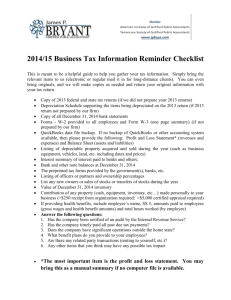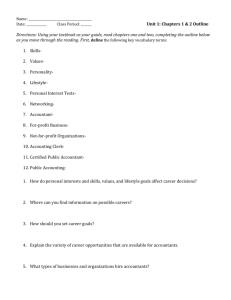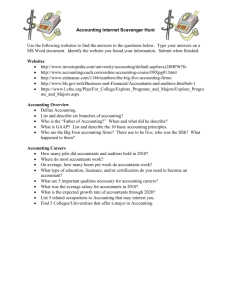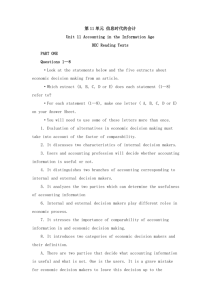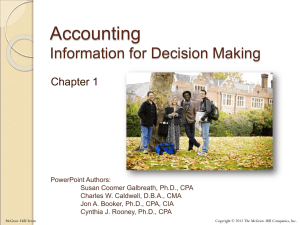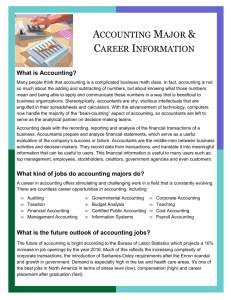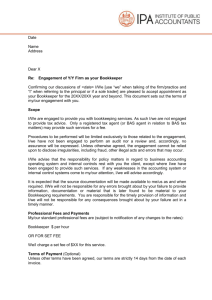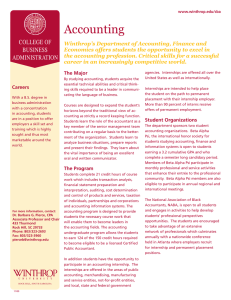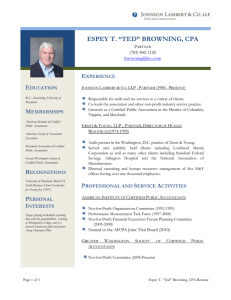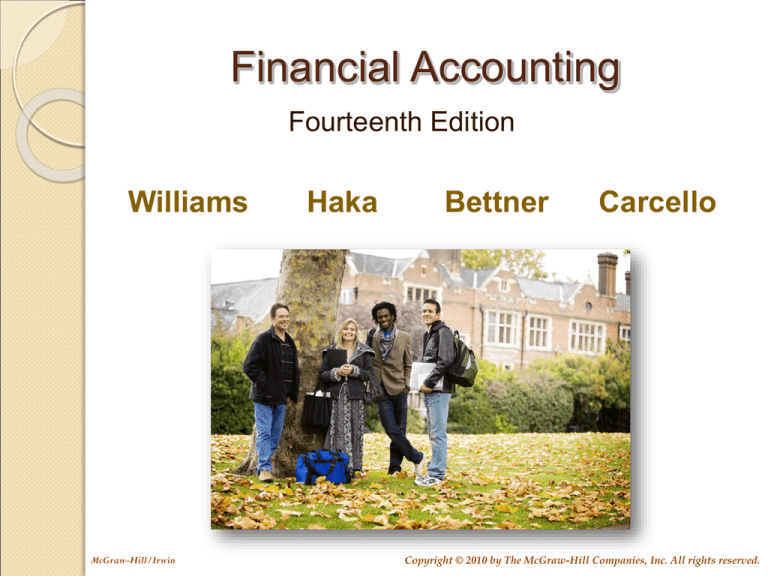
Financial Accounting
Fourteenth Edition
Williams
McGraw-Hill/Irwin
Haka
Bettner
Carcello
Copyright © 2010 by The McGraw-Hill Companies, Inc. All rights reserved.
Accounting:
Information for Decision Making
Chapter 1
1-2
The
Accounting
Process
Economic
Activities
Actions
(decisions)
Accounting links
decision makers
with economic
activities and
with the results of
their decisions.
Decision
Makers
Accounting
Information
Reported
Results of
Actions
(decisions)
1-3
Types of Accounting Information
Financial
Tax
Management
1-4
Accounting Systems
An accounting system consists of the
personnel, procedures, technology, and
records used by an organization to
develop accounting information and to
communicate this information to
decision makers.
1-5
Information System
Information
Users
Investors
Creditors
Managers
Owners
Customers
Employees
Regulators
-SEC
-IRS
-FTC
Financial
Information
Provided
Profitability
Financial
position
Cash flows
Decisions
Supported
Performance
evaluations
Stock
investments
Tax strategies
Labor relations
Resource
allocations
Lending
decisions
Borrowing
1-6
Determining Information Needs
Although much accounting information
clearly is essential to business operations,
management still has many choices as to
the types and amount of accounting
information to be developed.
1-7
Basic Functions of an Accounting
System
Interpret
and record
business
transactions.
Classify
similar
transactions
into useful
reports.
Summarize
and
communicate
information to
decision
makers.
1-8
Components of Internal Control
Control
Environment
Risk
Assessment
Control
Activities
Information and
Communication
Monitoring
1-9
External Users of Accounting
Information
• Owners
• Creditors
• Potential investors
• Labor unions
• Governmental agencies
• Suppliers
• Customers
• Trade associations
• General public
1-10
Objectives of External Financial
Reporting
Provide specific information about
economic resources, claims to resources,
and changes in resources and claims.
Provide information useful in assessing
amount, timing and uncertainty of future
cash flows.
Provide general information useful in
making investment and credit decisions.
1-11
Objectives of External Financial
Reporting
The primary financial
statements.
Balance
Sheet
Income
Statement
Statement
of Cash
Flows
1-12
Characteristics of Externally
Reported Information
A Means to an
End
Usefulness
Enhanced via
Explanation
Broader than
Financial
Statements
Based on GeneralPurpose
Assumption
Historical in
Nature
Results from Inexact and
Approximate Measures
1-13
Users of Internal Accounting
Information
Board of directors
Chief executive officer (CEO)
Chief financial officer (CFO)
Vice presidents
Business unit managers
Plant managers
Store managers
Line supervisors
1-14
Owners
Board of
Directors
Chief Executive
Officer
(CEO)
V.P
Ethics
Business
Unit
Managers
V.P.
Human
Resources
Plant
Managers
Plant
Managers
Plant
Accountants
Plant
Accountants
Typical
Simple
Organization
Chart
V.P.
Information
Services
Chief
Financial
Officer (CFO)
Controller
Treasurer
1-15
Objectives of Management
Accounting Information
To help achieve
goals and
missions
To help evaluate
and reward
decision makers
1-16
Characteristics of Management
Accounting Information
Timeliness
A Means to an
End
Measures of
Efficiency and
Effectiveness
Identify
Decision Maker
Oriented Toward
Future
1-17
Institutional Features
Generally Accepted Accounting Principles (GAAP)
Financial Accounting Standards Board
International Accounting Standards Board
Securities and Exchange Commission
Public Company Accounting Oversight Board
Audits of Financial Statements
Legislation
1-18
Professional Organizations
American Institute of Certified Public Accountants
Institute of Management Accountants
Institute of Internal Auditors
American Accounting Association
Committee of Sponsoring Organizations of the
Treadway Commission (COSO)
1-19
Competence, Judgment and
Ethical Behavior
Certified Public Accountant (CPA)
Certified Management Accountant (CMA)
Certified Internal Auditor (CIA)
Ethical behavior is the
cornerstone of the
accounting
profession.
1-20
Careers in Accounting
Public Accounting
Management Accounting
Governmental Accounting
Accounting Education
1-21
What About Bookkeeping?
Bookkeeping is the clerical side of accounting—
the recording of routine transactions and day-today record keeping.
Professional accountants are involved more with
the interpretation and use of accounting
information than with its actual preparation.
1-22
I’m Not An Accounting Major
Accounting is the language of business,
and trying to run a business without
understanding accounting information is
analogous to trying to play sports without
understanding the rules.
1-23
Ethics, Fraud & Corporate
Governance
Corporate governance entails corporate
structures and processes for overseeing
the company’s affairs to ensure that the
company is being managed with the best
interests of shareholders in mind.
Dennis Kozlowski, the former CEO
of Tyco, was sentenced to 8 1/3 to
25 years in prison for his
conviction for conspiracy,
securities fraud, and falsifying
records.
1-24
End of Chapter 1
1-25

